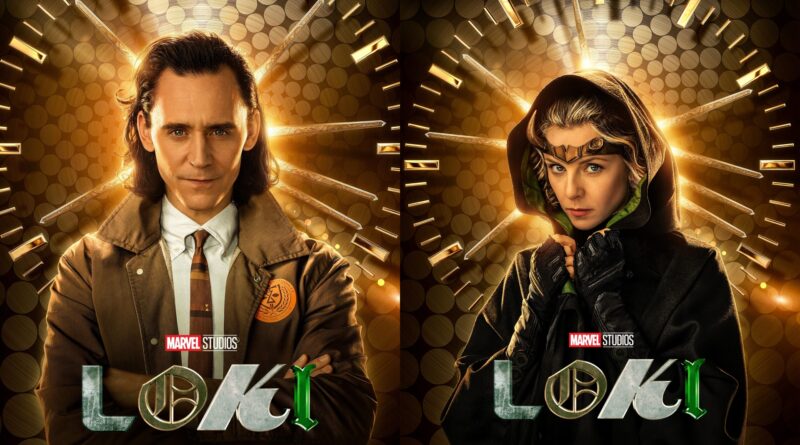
Comics Corner – A 1000 year history of Loki’s sexuality
The recently concluded first season of Loki on Disney+ finally delivered something fans have been asking for since the Marvel Cinematic Universe began – an openly LGBTQ+ protagonist.
While previous Marvel films and shows have either pulled a glorified bait-and-switch (Avengers: Endgame’s ‘first gay character’ turning out to be an unnamed civilian in a therapy group) or merely laid the groundwork for future queer superheroes (the Scarlet Witch’s children in WandaVision, Billy and Tommy, who grow up to be Wiccan and Speed, respectively), Loki firmly establishes both the Norse god of mischief (played by Tom Hiddleston) and his female counterpart Sylvie (Sophia Di Martino) as bisexual.
Even though the show never actively showed either version of Loki with a same-sex partner, it’s a welcome move just to have their bisexuality acknowledged – especially for the male incarnation of Loki, as male bisexuality is so often ignored. It was also gratifying to see the show acknowledge that Loki is genderfluid, although this may have been easier to miss – when Loki is arrested by the Time Variance Authority, a file can be seen that lists Loki’s sex as “fluid”.
Both are developments that were a long time coming, not least because Loki’s gender and sexuality have both long been established in the comics. They even have their roots in real-world Norse mythology, dating back to circa 790CE. In the Poetic Edda and Prose Edda, which contain the stories of the Norse pantheon, Loki shape-shifted and took lovers of all kinds. There are tales of Loki living “eight winters” on Midgard – you know it as “Earth” – as a milkmaid, and bearing children while she did, or even taking the form of a mare and getting impregnated by a mythical stallion called Svaðilfari, eventually giving birth to Sleipnir, Odin’s eight-legged horse.
In the comics, Loki’s sexuality and gender are a little harder to pin down – not least because for much of the character’s published history, he existed under the Comics Code Authority, which frowned upon depictions of any sexuality, let alone same sex pairings. Comic book Loki was also squarely a villain for decades, enemy to his adoptive brother Thor and more likely to be referred to as the God of Evil or God of Lies than as the more charming God of Mischief.
This Loki first appeared in Journey Into Mystery #85 in 1962, created by Stan Lee, Larry Lieber, and Jack Kirby, and his machinations would lead to the formation of the Avengers. Although a ‘prototype’ of the character had shown up in Venus #6 in 1949, there was no real connection to Thor, and he was the ruler of Hades, the Greek underworld. By Venus #10, he had even taken to calling himself Satan. Despite the lack of meaningful connections, a 2011 comic retroactively confirmed the Loki/Satan in Venus was indeed the same one that had plagued the Marvel Universe since Journey Into Mystery. Either way, as a villain, romance was not a top focus for stories involving him.

Loki’s queer mythological roots wouldn’t begin to bleed into the comics until 2008 – and it was ‘his’ gender fluidity that made an appearance first. In Thor #5, the eponymous God of Thunder is rebuilding Asgard in the wake of Ragnarok, a cycle of destruction and rebirth central to Norse myth. In the Marvel Universe, this meant the gods were trapped in mortal form, most unaware of their divine origins – including Loki. However, while most of the gods returned as they were when awakened by Thor, Loki returned as a woman.
This reborn Loki claimed to want to turn over a new leaf, with the Goddess of Lies swearing never to lie again. However, she was still firmly evil, and became the serpent in the garden of the reborn Asgard, manipulating people to her whims by only telling the truth, usually in the form of revealing deeply buried secrets. This “Lady Loki” would prove to be as great a threat to Thor and the wider Marvel Universe as she ever was as a man, yet showed the first signs of redemption when she came to the aid of the Avengers against a monstrous force called The Void, losing her life in the process.
In comics, like mythology, death rarely sticks though, and Loki was soon reborn again, back to a male body as “Kid Loki“. Unlike previous incarnations, this Loki managed to change his script and became good – before being killed and replaced by an echo of his past self. This version of Loki would be a far more nuanced version of the character – born of evil Loki, influenced by the guilt of killing good Loki – and go on to form a new iteration of the Young Avengers.

It’s here where Loki’s bisexuality became more apparent – he flirted with team mate Prodigy, saying Asgardian culture “doesn’t really share your concept of sexual identity”. This was meant to be more prominent in Loki’s next series, Loki, Agent of Asgard, although it was rumoured that Marvel changed its mind on allowing this.
Nevertheless, Loki’s inherent queerness was now firmly established. Later titles, such as Vote Loki – the inspiration for the ‘President Loki’ seen briefly on the Disney+ show – have Loki regularly switching genders to suit their needs or even just their mood, and has been shown charming the pants off characters of all genders.

A parallel to the female Loki on the TV series is trickier to chart though – despite being ostensibly inspired by the Loki of myth’s penchant for swapping genders and the ‘Lady Loki’ period of the comics, the show’s Sylvie is closer to an amalgamation of two versions of Thor villain (and occasional love interest) The Enchantress. She blends elements of the Asgardian Amora with the human successor to the title of Enchantress, Sylvie Lushton. However, in MCU canon, Di Martino’s is definitely a Loki, and it was she who first brought up both her and male Loki’s bisexuality, confirming it for the ages.
With Loki’s gender and sexuality now entrenched in mainstream awareness thanks to the TV series, hopefully we’ll see it explored more thoroughly in the comics going forwards. With any luck, Loki season two will also find a way to incorporate the character’s bisexuality onscreen, too.













Comments are closed.